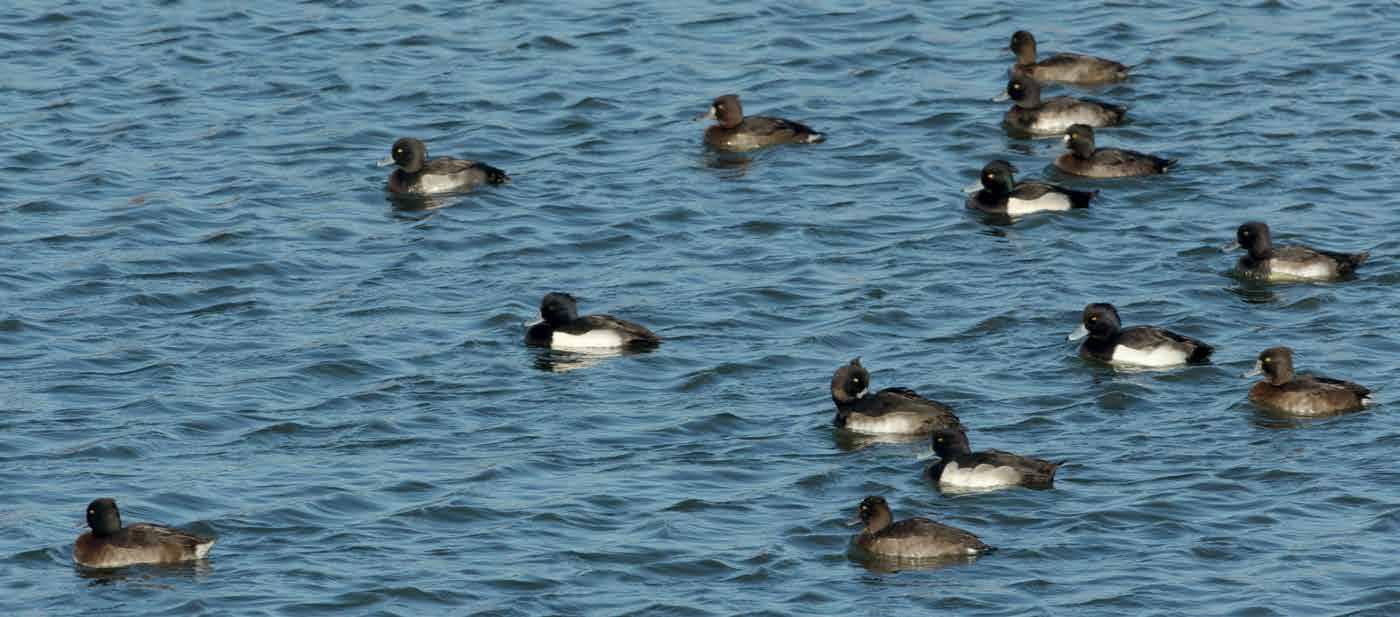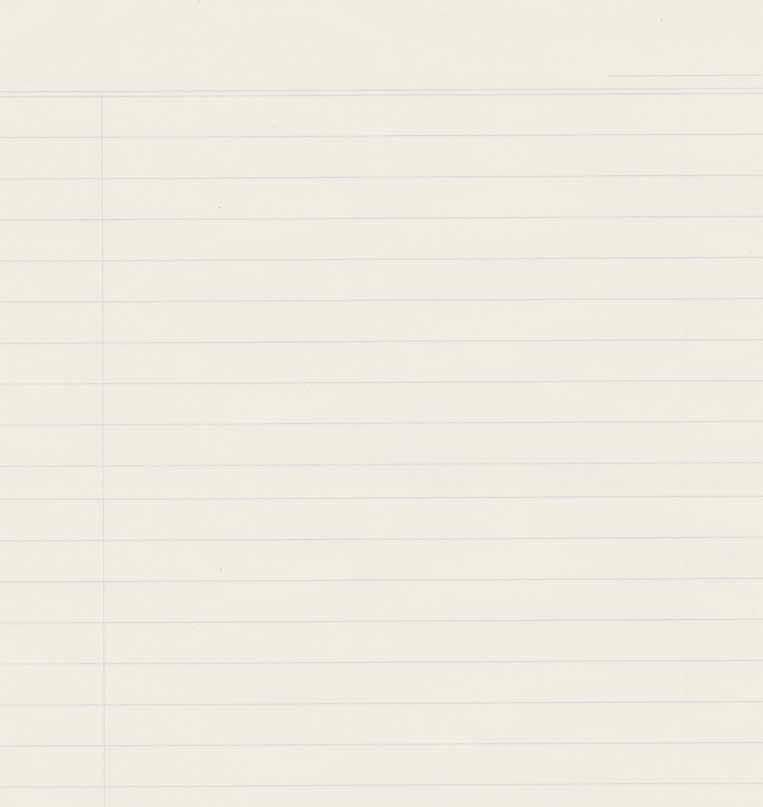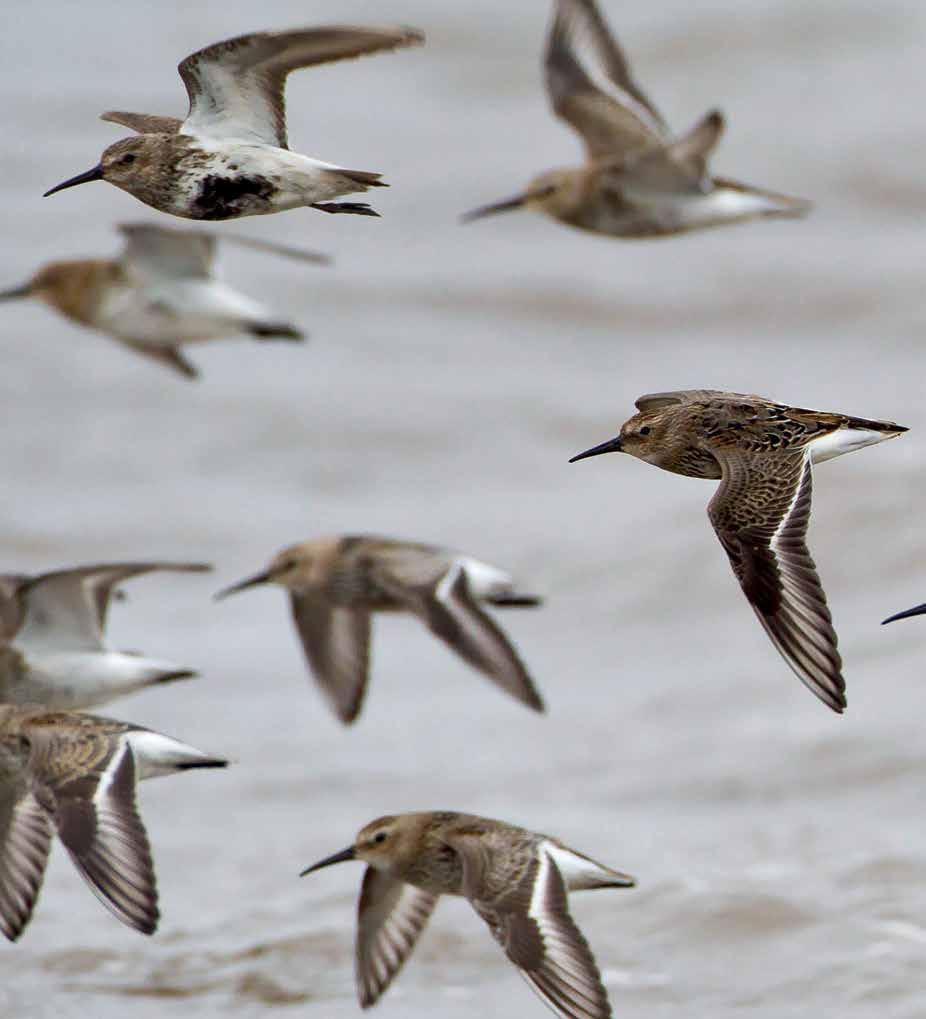
8 minute read
AGE AND SEX RECORDING
Age and sex recording in WeBS
A new feature in WeBS Online allows counters to record proportions of male and female or adult and first-year birds to help research into productivity and populations.
Teresa Frost WeBS National Organiser
In January 2020, we launched a new feature in WeBS Online data entry, to allow counters to optionally record the number of birds of different ages and sexes for certain wildfowl and wader species. This might be all the birds of a particular species present, or a sample from larger flock(s). The data gathered will be invaluable for future analyses of breeding success by looking at age composition across years, and tracking changes in migratory behaviour by recording the ratio of male to female birds.
WHY AGE DATA?
WeBS Core Counts allow us to track how whole populations are doing. But additional information is needed to understand the drivers behind the headline trends. Collecting information on age ratios is one way to get information on breeding success. Productivity is an important demographic factor affecting populations, helping us to understand why WeBS and international population trends are increasing or decreasing. Many of the waders we count in winter breed in the high Arctic, where it is difficult to monitor breeding success. By counting the proportion of first calendar year birds we see in a flock, we are able to gain valuable information on breeding success. Wader ringing projects collect data at places like the Wash and the Swale, but there are other parts of the country where no ringing is done, and WeBS counters can help fill the gap.
Proportions of juvenile birds in flocks can give an indication of breeding success
WHY SEX DATA?
Just as with age data, information on sex ratios will give us finer detail of population structure in different months and different parts of the country, and whether these differ from year to year. We know that there are considerable differences in overall sex ratios in many wintering duck flocks and that a greater proportion of males are found in the north of the
flyway. Collection of sex ratio data can provide useful data for investigating differences in survival between the sexes. Timing of migration, and moult migrations are also known or suspected to differ between sexes for several species and after a few years of data collection, it is hoped we can shed some light on this – perhaps you could collect data regularly at your site, to see how it varies over time?
HOW TO HELP
Recording age and sex data need not be done on every WeBS Count, or for every species, to be useful. There are two times of year where it will be particularly helpful. We are keen to receive samples of duck sex ratios in January, as this is when the Duck Specialist Group encourages data collection alongside the International Waterbird Census. Early autumn is a helpful time to collect juvenile wader data, of interest to the International Wader Study Group.
If you don’t have time to collect the data during your Priority Core Count, you could go back on a different day, and submit data with a casual count or supplementary count. And if you aren’t confident enough of your age/sex identification skills for certain species to take part, don’t worry – you can still do your WeBS count as normal, as age and sex recording will remain entirely optional.
We will highlight future project research requests via this newsletter, social media and your friendly Local Organisers. For example, Ros Green explains what summer breakdowns by age and sex for Shelduck could help reveal on page 14.
Remember, you do not have to collect data on every bird present on your count, just representative samples. To avoid bias, we ask about the “flock size” you are drawing each sample from. If you are only able to see enough detail on birds close by to age them, a further away group might have a different age structure to the one close to you, so it helps to know what proportion of the birds on your sector you drew the samples from by giving the flock size as well as your usual total sector count. Or perhaps there are two groups of ducks in your WeBS sector, a big flock of mostly males and a small flock of mostly
Try to select your age or sex samples to reflect the birds on your sector

females – we need to know which sample is from which flock to be able to calculate the overall ratio correctly.
If you do not use WeBS Online, but submit paper forms to your Local Organiser or the WeBS Office, and want to take part you will need to record the information separately. If there is sufficient demand, we will create a supplementary form that can be used, so please let us know.
So far we have received 541 age samples and 2,188 sex samples – many thanks to all of you who have submitted data, but we would be delighted to have some more! As we mentioned in WeBS News 35, the very first National Wildfowl Counts forms from the 1940s used to have space to record this information, so this is a return of data collection after a very long hiatus! We are looking forward to being able to compare some recent data with data from over 70 years ago, once we have digitised some historical forms.
Continued overleaf
If you already undertake field-based age assessments for WWT, please continue to submit your counts to WWT in the usual way. WWT undertake age assessments on Whooper Swan and Bewick’s Swan and eleven goose populations native to the UK. They collate information on breeding success using the proportion of young (firstwinter) birds in non-breeding flocks and the average brood size. For further information contact: https://monitoring.wwt.org.uk/ contact-us/
Log into WeBS Online and enter count data. You will see that there is a percentage symbol (%) next to each species where recording of age or sex is permitted. To enter age/sex recordings for a particular species, click on this symbol. Note, that if you have not marked this species as present first, it is not possible to select this option. You must ensure that the species is either marked as present or a count has been added before you can add age/sex recordings.
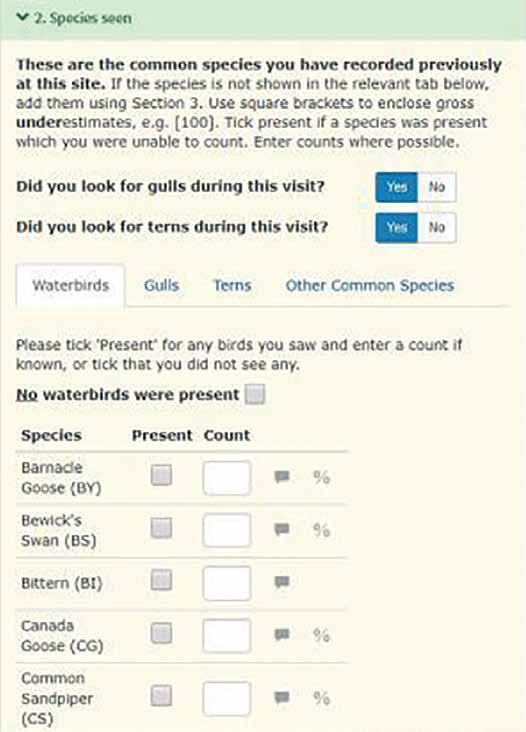
100% Unless you are recording age and sex composition for all birds within your WeBS count sector, please enter data for samples for separate flocks, so that we can calculate proportions correctly. The reason we ask for samples divided into flocks is that sometimes birds separate into flocks with e.g. mostly adults or mostly males in one part of a count sector.
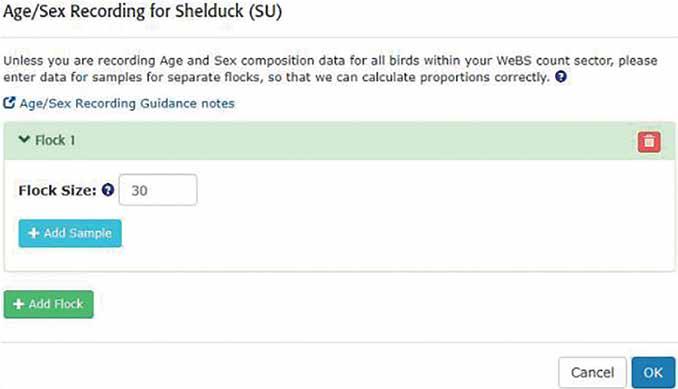
To enter data, select the green ‘+ Add Flock’ button. From here, you can enter the size of Flock 1. The size of Flock 1 will default to your WeBS sector total. If the flock you are sampling from is smaller than this, as the sector is split into separate flocks, please estimate the size here, so we know how representative your samples are.
Full Guidance, including tables of which species can be recorded and suggested months where this is possible taking into account plumage and moult, can be found in the counter resources on the WeBS website, via the help button in WeBS Online, or at bit.ly/WeBSAgeSex.
75%
50%
25% Male
Indeterminate

Female
0%
Jan Feb Mar Apr May Jun Jul Aug
Sep Preliminary Mallard results suggest that fewer females are detected between March and June on WeBS counts, which is when they are incubating, and highlights the moulting period where it is more difficult to distinguish females from males in eclipse plumage.
To add age recordings, select the blue ‘+ Add Sample’ button and select ‘Age’. This will then show options for you to type in the number of birds seen which were at ‘Adult’, ‘1st Calendar Year’ and ‘Indeterminate’ ages. You can add as many samples as required. To add sex recordings, once again select ‘+ Add Sample’ and select ‘Sex’. This will then show options for you to type in the number of birds seen which were at ‘Male’, ‘Female’ and ‘Indeterminate’ sex. You can add as many samples as required. If you are recording both age and sex samples, these do not necessarily have to be the same. You could for example record three samples from the flock for Sex and only one for Age. You will see that the total number birds assessed for age and the total assessed for sex within the flock is kept up-to-date underneath the ‘+ Add Sample’ button, so that you can ensure the numbers recorded for age and recorded for sex for the samples do not exceed the total flock size. To add data for additional flocks, select ‘+ Add Flock’ and carry out the same process. The total for all the flocks is given underneath the ‘+ Add Flock’ button, so that you can ensure the totals do not exceed the WeBS count total. You can delete specific flocks, age and sex counts by selecting the red bin button at the top right hand corner of the corresponding sections. Once you have entered all the Age/Sex recordings for a specific species, select ‘OK’ and the box will disappear. If sample numbers are too large within a specific flock e.g. you have recorded a total of 26 birds across all samples in Flock 1, which is greater than the flock size (10), an error message will occur and you cannot submit the data until this has been corrected. Once all age/sex recordings have been noted, please submit your data by selecting ‘Submit Count’.
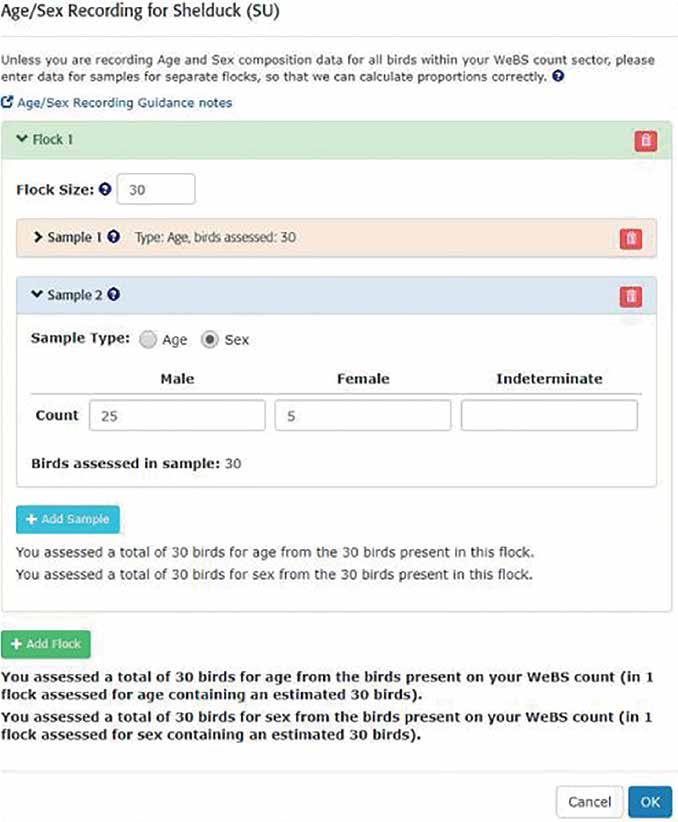
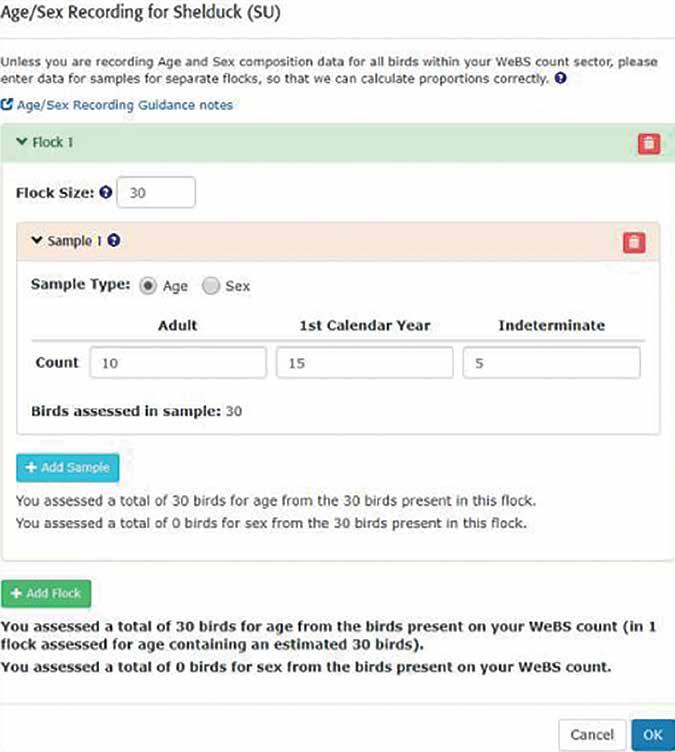
Proportions of males and females can indicate differences in distribution and winter survival
